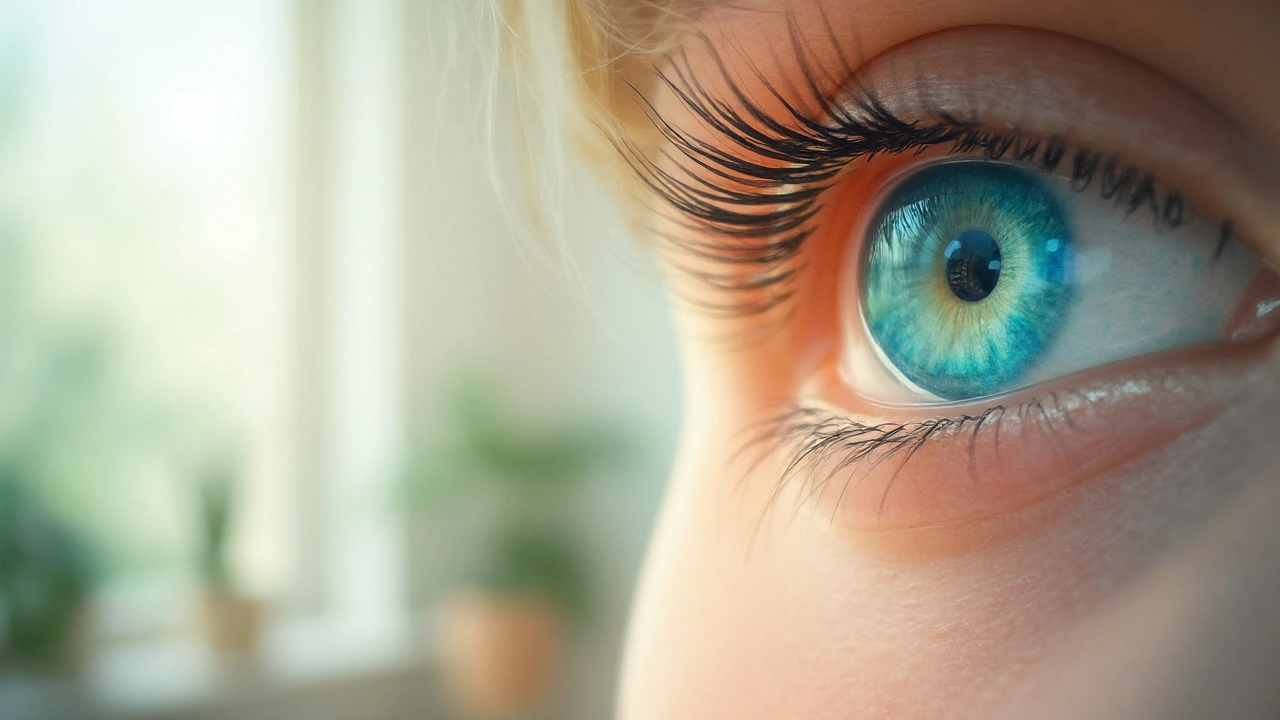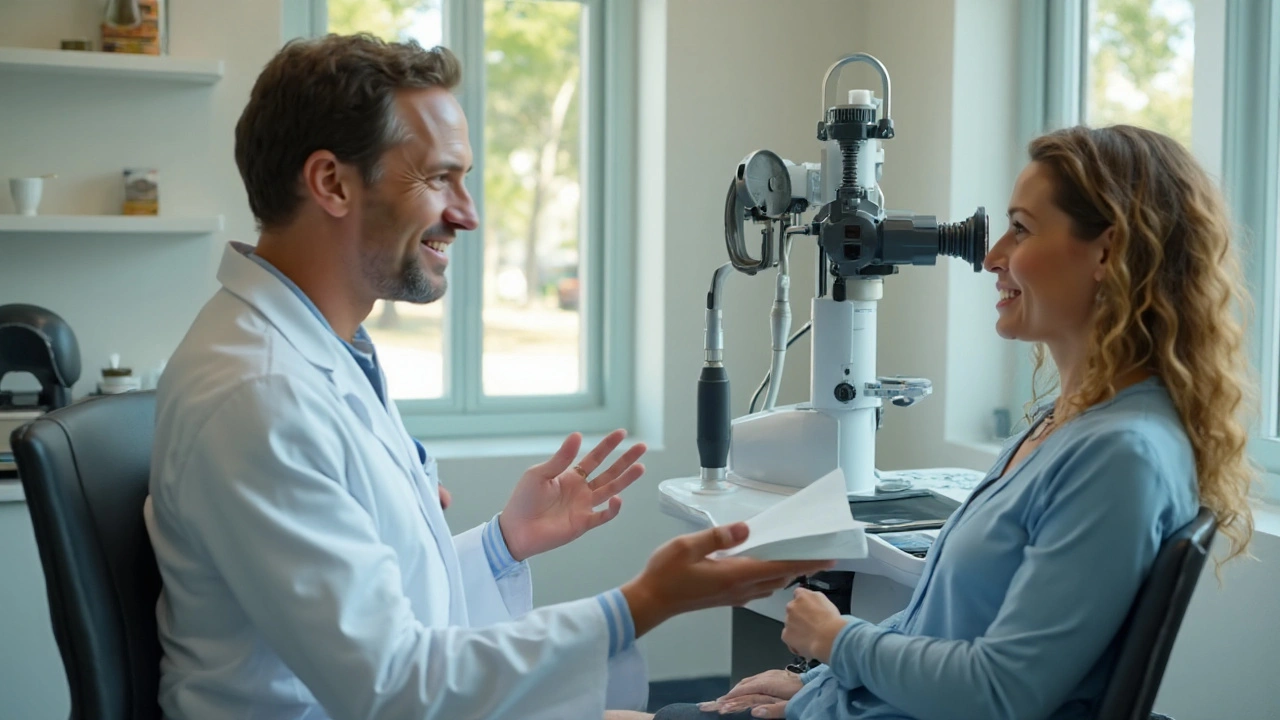
Glaucoma is a chronic eye disease that damages the optic nerve and leads to irreversible vision loss if untreated. Elevated intraocular pressure (IOP) is the most common trigger, but researchers now link psychological stress to faster progression.
Why Stress Matters for Eye Health
Stress isn’t just a mental feeling; it triggers a cascade of hormones-most notably cortisol a glucocorticoid released by the adrenal glands during the fight‑or‑flight response. High cortisol levels can alter fluid dynamics inside the eye, raising IOP and putting extra strain on the optic nerve. Over time, this can accelerate the visual field loss that characterizes glaucoma.
Key Players in the Stress‑Glaucoma Connection
- Intraocular pressure (IOP) the fluid pressure inside the eye; normal range is 10‑21 mmHg
- Optic nerve the bundle of retinal ganglion cell axons that transmits visual information to the brain
- Visual field loss the gradual loss of peripheral vision, a hallmark of advanced glaucoma
- Cortisol stress hormone that can affect eye fluid production and drainage
- Primary open‑angle glaucoma (POAG) the most common form, characterized by slow drainage of aqueous humor
- Angle‑closure glaucoma a sudden blockage of fluid outflow, often triggered by pupil dilation
- Stress management techniques like mindfulness, exercise, and therapy that lower cortisol
- Ophthalmologist eye‑care specialist who monitors IOP and visual fields
How Stress Physically Raises IOP
When you’re stressed, the body releases norepinephrine and adrenaline, tightening the muscles around the eye’s drainage canals (the trabecular meshwork). This narrowing reduces outflow of aqueous humor, causing pressure to climb. Studies from the American Academy of Ophthalmology show that a single stressful episode can spike IOP by 2‑4 mmHg in susceptible individuals.
Comparing Glaucoma Subtypes
| Attribute | Primary Open‑Angle Glaucoma | Angle‑Closure Glaucoma |
|---|---|---|
| Typical IOP range | 15‑30 mmHg | 30‑60 mmHg (rapid rise) |
| Common age | 40‑70 years | 50‑70 years |
| Stress sensitivity | Moderate - chronic stress can accelerate progression | High - acute stress can trigger an attack |
| First‑line treatment | Prostaglandin eye drops | Immediate laser peripheral iridotomy |
Both forms share the same end‑point-optic nerve damage-but the way stress interacts varies. POAG patients often experience a steady pressure rise, making chronic stress a silent accelerator. Angle‑closure patients may see a sudden IOP spike during high‑adrenergic events such as an anxiety attack.
Real‑World Example: The Office Executive
Mark, a 58‑year‑old marketing director, was diagnosed with POAG five years ago. He followed his ophthalmologist’s regimen of daily eye drops, but his visual fields kept narrowing. A lifestyle audit revealed that his high‑pressure job, frequent overtime, and insomnia were keeping cortisol elevated. After introducing a structured stress‑reduction plan-daily 10‑minute breathing exercises, regular cardio, and reduced caffeine-his quarterly IOP measurements dropped from an average of 24mmHg to 19mmHg, and his visual field loss slowed dramatically. Mark’s story illustrates that managing stress isn’t just a comfort measure; it can have measurable effects on glaucoma progression.

Practical Strategies to Keep Stress from Worsening Glaucoma
- Monitor IOP Regularly: Use home tonometry devices or schedule check‑ups every 3‑6 months. Knowing your baseline helps spot stress‑related spikes early.
- Adopt Mind‑Body Techniques: Mindfulness meditation, yoga, or progressive muscle relaxation have been shown to cut cortisol by up to 30% in clinical trials.
- Exercise Consistently: Moderate aerobic activity (30 minutes, 5 days a week) improves blood flow to the optic nerve and lowers systemic blood pressure, indirectly supporting eye‑pressure regulation.
- Prioritize Sleep: Aim for 7‑8 hours; deep‑sleep deficiency spikes cortisol and can raise IOP.
- Limit Stimulants: Caffeine and nicotine can cause transient IOP spikes; reducing intake helps keep pressure stable.
- Seek Professional Help: Cognitive‑behavioral therapy (CBT) or counseling can provide tools to manage chronic anxiety, a known risk factor for glaucoma progression.
Implementing even three of these habits often yields a noticeable drop in stress‑related pressure spikes.
When Stress Might Signal an Acute Glaucoma Attack
Acute angle‑closure glaucoma presents with sudden eye pain, halos around lights, nausea, and a rapid rise in IOP. Stressful events-like a panic attack or intense physical exertion-can precipitate such an episode. If you notice these symptoms, treat it as an emergency: call an ophthalmologist immediately. Timely laser iridotomy can relieve blockage and preserve vision.
Linking Glaucoma to Overall Health
Glaucoma doesn’t exist in a vacuum. High blood pressure, diabetes, and sleep apnea all intersect with stress pathways, creating a cumulative risk profile. Managing systemic health together with stress reduction creates a synergistic effect: lower blood pressure reduces ocular perfusion pressure fluctuations, while stable glucose levels keep retinal vessels healthy.
Future Directions: Stress‑Targeted Therapies
Researchers are testing drugs that blunt cortisol’s ocular effects. One trial from the University of California, San Francisco is evaluating a topical glucocorticoid‑receptor antagonist for POAG patients with high stress scores. Early results suggest a modest IOP reduction of 1.8mmHg, hinting at a new class of treatments that address the mind‑eye connection.
Takeaway Checklist
- Know your baseline IOP and visual field status.
- Track stress levels with a simple diary or a mobile app.
- Incorporate at least two stress‑reduction habits into daily life.
- Consult your ophthalmologist about how stress might affect your glaucoma plan.
- Act fast if you experience sudden eye pain or vision changes.

Frequently Asked Questions
Can everyday stress really increase eye pressure?
Yes. Acute stress triggers hormones that tighten eye‑drainage pathways, often raising IOP by 2‑4 mmHg. Over time, repeated spikes can accelerate glaucoma damage.
Is there a specific type of glaucoma that’s more sensitive to stress?
Angle‑closure glaucoma is especially sensitive to sudden stress because rapid pupil dilation can block fluid outflow. Primary open‑angle glaucoma is affected more by chronic, low‑grade stress.
What are the best ways to lower cortisol for eye health?
Mindfulness meditation, regular aerobic exercise, adequate sleep, and limiting caffeine are proven to cut cortisol levels. If needed, counseling or CBT can provide additional support.
Should I change my glaucoma medication if I’m stressed?
Medication changes should be guided by your ophthalmologist. Often, adding a stress‑management plan is enough, but in some cases doctors adjust eye‑drop regimens to counteract pressure spikes.
How quickly can stress‑reduction lower intraocular pressure?
Studies show measurable IOP reductions within 4‑6 weeks of consistent meditation or exercise programs, especially in patients with baseline pressures under 25mmHg.
Are home IOP monitors reliable for tracking stress effects?
Modern handheld tonometers are fairly accurate (±2mmHg) when used correctly. They’re a useful adjunct to clinic visits but shouldn’t replace professional exams.
Can diet influence stress‑related glaucoma risk?
A diet rich in omega‑3 fatty acids, leafy greens, and antioxidants supports vascular health and may buffer stress hormone spikes. Reducing processed sugar also helps keep cortisol in check.



So you're telling us that a little anxiety can magically shove the pressure up in our eyeballs? That's the kind of pseudo‑science that makes me roll my eyes so hard I see my own retina. Stress is a vague buzzword that marketers love, not a proven villain in glaucoma. If you looked at the raw data, you'd see that most IOP spikes are linked to posture, caffeine, or medication non‑adherence, not some ethereal cortisol monster. Sure, cortisol exists, but its effect on the trabecular meshwork is barely measurable compared to mechanical factors. I'd rather focus on proven interventions than chase after every emotional wave.
Life's pressures mirror the fluid dynamics in our eyes; when the external world overwhelms us, the inner balance falters.
I get where you're coming from-stress can feel like a hidden weight that tiptoes into our health. Adding a quick breathing break or a short walk can give the drainage pathways a chance to relax. It's amazing how a few minutes of mindfulness can shave a couple of millimeters off the pressure reading. If you keep a simple log of stress triggers alongside your IOP numbers, patterns start to emerge. That way you can pinpoint the exact moments when stress spikes your eye pressure and act before damage accumulates. Keep it consistent and you’ll likely see the benefit.
While the article presents a compelling narrative, it overlooks several pivotal studies that have failed to demonstrate a statistically significant correlation between chronic stress and progressive glaucoma. Moreover, the emphasis on cortisol as a primary mediator neglects the role of autonomic dysregulation, which can independently affect ocular perfusion. The cited increase of 2‑4 mmHg during acute stress episodes is derived from a limited cohort, raising concerns about external validity. Additionally, the recommendation of home tonometry, though convenient, glosses over calibration challenges that can lead to misleading readings. It would be prudent to integrate a more balanced view, acknowledging both the potential link and the substantial gaps in current evidence. Future research should adopt larger sample sizes and longitudinal designs to clarify causality. Until then, clinicians ought to prioritize established risk factors such as IOP control and vascular health. Overstating the stress connection may inadvertently divert attention from proven therapeutic strategies.
I notice that many patients with angle‑closure episodes mention recent high‑stress events, which could hint at a physiological trigger beyond mere coincidence.
It’s understandable to feel overwhelmed when juggling eye health and daily pressures. The good news is that stress‑reduction techniques are low‑risk and can complement your existing treatment plan. Regular aerobic exercise not only lowers systemic blood pressure but also improves ocular blood flow, potentially easing IOP fluctuations. Mindfulness meditation, even in short 5‑minute bursts, has been shown to dampen cortisol spikes. By weaving these habits into your routine, you give your optic nerve a stronger chance to stay healthy.
Great point! 😊
First, let’s acknowledge that the eye is a pressure‑sensitive organ, and any factor that nudges that pressure can, in theory, influence disease progression. Studies using handheld tonometers have recorded transient IOP elevations during mental arithmetic tasks, suggesting a neuro‑endocrine link. However, the magnitude of those spikes often falls within the instrument’s margin of error, which raises questions about clinical relevance. That said, chronic exposure to elevated cortisol can remodel the extracellular matrix of the trabecular meshwork, potentially reducing outflow facility over months or years. Lifestyle interventions such as regular aerobic activity increase nitric oxide production, which promotes vasodilation and may aid aqueous humor drainage. Consistent mindfulness practice has been associated with a 10‑15 % reduction in baseline cortisol, translating into modest but measurable IOP declines in some cohorts. Moreover, adequate sleep restores the circadian rhythm of intraocular pressure, preventing nocturnal surges that are otherwise unnoticed. Dietary choices rich in omega‑3 fatty acids also support anti‑inflammatory pathways, which could indirectly benefit outflow channels. On the medication front, clinicians sometimes adjust prostaglandin analog dosage in patients reporting high stress, aiming to counteract any pressure uptick. It is crucial, however, to differentiate between stress‑induced fluctuations and medication non‑adherence, as the latter remains the leading cause of uncontrolled IOP. Patient education should therefore include a simple stress diary alongside medication logs, enabling pattern recognition. When the diary reveals consistent peaks after stressful meetings, targeted relaxation techniques can be prescribed as adjunct therapy. In practice, I’ve seen patients who added a 10‑minute breathing exercise before bedtime experience steadier IOP readings over three months. Lastly, keep in mind that the psychosomatic component of glaucoma is an evolving field, and while we have promising data, more robust randomized trials are needed to cement guidelines. Until then, a holistic approach-combining medical therapy, stress management, and regular monitoring-offers the best chance to preserve vision. 😊
Remember, every small step you take toward lowering stress is a victory for your eyes-keep at it, and the results will follow!
It’s wild how a hectic day can feel like a pressure cooker for the eyes, almost like the body’s warning system is flashing red.
Absolutely love seeing real‑world examples of stress‑reduction actually moving the needle on eye pressure!!! 🌟 Keep sharing those success stories, they inspire us all!!! 😊
From a clinical standpoint, the primary goal remains maintaining IOP within target range, but incorporating stress‑management can serve as an adjunctive tool. Evidence suggests that consistent yoga practice may modestly lower nocturnal IOP peaks, which are otherwise hard to capture in office visits. Additionally, patients who track their perceived stress alongside pressure readings often identify subtle patterns that inform medication timing. It’s also worth noting that beta‑blocker eye drops may blunt the sympathetic surge associated with acute stress, offering a dual benefit. Ultimately, a personalized plan that blends pharmacology with lifestyle modifications yields the most resilient outcomes.
I’m not convinced the pharma industry is pushing the stress link just to sell more eye drops; they love to tie every problem to a new “solution”.
The article cherry‑picks data and ignores studies that show no real effect of stress on glaucoma progression.
Sounds like another hype piece to me-too much drama, not enough hard facts.
While we may disagree on the magnitude of stress’s impact, fostering a supportive community where patients share coping strategies can only benefit overall eye health.
It is essential that we prioritize scientifically validated treatments over anecdotal claims, especially when national health resources are finite.
In truth, the neuro‑endocrine pathway involving corticotropin‑releasing hormone has been mapped in animal models, indicating a plausible mechanistic bridge between psychological stress and aqueous humor dynamics.
Look, I’ve read dozens of papers on this topic and most of them are riddled with methodological flaws; small sample sizes, poorly controlled stressors, and an overreliance on self‑reported anxiety scales make the whole premise shaky at best. The authors of the article seem eager to sell a narrative that stress is a villain without providing robust statistical backing. Moreover, they ignore the role of systemic hypertension, which is a far more established risk factor for optic nerve damage. It’s also baffling that they reference a handful of studies from the early 2000s and pretend the field hasn’t advanced since then. If you really want to understand the interplay between mind and eye, you need to look at longitudinal cohorts with objective biomarker measurements, not anecdotal case reports. Until such data surface, readers should take the stress‑glaucoma connection with a grain of salt. 😊
Integrating psychophysiological monitoring-such as heart‑rate variability (HRV) metrics-with serial tonometry could create a composite stress‑IOP index, enabling clinicians to tailor intervention intensity based on real‑time autonomic fluctuations.